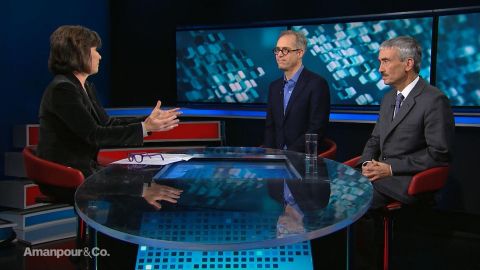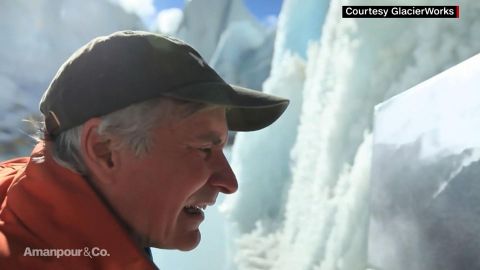Read Transcript EXPAND
CHRISTIANE AMANPOUR: Now, one of the key drivers of global migration, including from Central America, as we’ve discussed, is, of course, climate change. And one man wants to show how quickly our world is changing. A great American mountaineer and filmmaker, David Breashears, has made his career climbing Mt. Everest. It is the world’s highest mountain and he worries about what he’s seeing there just as climbers push the limits of their bodies. David Breashears says we are now testing the very limits of our earth and he tells our Hari Sreenivasan what the glaciers are telling or rather how the glaciers are telling this story.
HARI SREENIVASAN: So you have been to the top of the world five times and now you’re focused on helping us figure out that the view is changing from the top. What’s different?
DAVID BREASHEARS, MOUNTAINEER AND FILMMAKER: Everything’s different when it comes to the glaciers and the ice up high in the mountain and the snow cover. It’s — I first went to the Himalaya, I was 23-years-old in 1979 and climbed a 22,500-foot peak. And if I was to go back and climb that peak again today, I would see a dramatically different snow and ice cover.
SREENIVASAN: Now, you’re focusing on something called “Match photography”. What is that?
BREASHEARS: Match photography is where I find an old photo point, say from an early explorer, mapmaker, cartographer and they were the first to capture images of the glaciers. Say George Mallory in 1921 or another photographer, Vittorio Sella, in 1899. I find that photograph in an archive, I make a print of it. I go to the spot, the photo point, at least try to find it and capture the same image with that time span in between.
SREENIVASAN: Is it easy to get to that same spot that that photographer stood at?
BREASHEARS: Sometimes it’s — sometimes we can find it fairly quickly. One photo point took us multiple efforts. It’s a photo point near K2 in the Karakoram range of Pakistan. And we were absolutely astonished at the difficulty of the terrain the photographer, Vittorio Sella, and his team of porters had climbed on. Not only did we have the problem with the terrain, we had problems with the weather, and we waited in camp after we found the location for 13 days on the glacier to capture the same image he had captured in 1909 and we were there in 2009.
SREENIVASAN: How significant is the change that you are able to see from the picture that was taken 50 years ago, 100 years ago, to what we’re seeing today?
BREASHEARS: The change is dramatic. When you see the match photos of Cho Oyu and the north side of Everest and the south side of Everest, anyone looking at these photos can see the change. What we’re really thinking about is the future change and what a recent report from ICIMOD, an organization in Nepal that studies these types of things said that by 2100, we expect to lose 80 percent to 90 percent of the mass of the 19,000 glaciers in the Hindu Kush Himalayan Region.
SREENIVASAN: So what are the consequences of losing 80 percent to 90 percent of the mass of glaciers?
BREASHEARS: Well, this is an imperiled ecosystem. The high mountain Alpine ecosystems are fragile. The glaciers are telling us something. They’re under tremendous stress. They’re under tremendous pressure. They’re not getting enough snow. The temperature is warming, and there’s black carbon being deposited on the snow. So what affects that ecosystem affects the livelihoods of over 230 million people who inhabit the region and there are manifold reasons how this effect plays out to hearty mountain people. They are very adaptable and resilient by their nature but this is — and they tend to be somewhat poorer than the rest of the people down the river. And they’re going to suffer the consequences of this stress on the ecosystem first.
SREENIVASAN: We’re going to take a look at a video that you have. It’s a compilation of different images around Everest. Tell us what we’re taking a look at.
BREASHEARS: We’re flying right towards Mt. Everest. That’s the black pyramid on the left. We’re passing Mt. Pumori on the right and we are about to cross this ridge and fly right over base camp. The peak on the right is Nuptse. The peak in the middle is Lhotse. We’re looking down on the Khumbu Icefall and we’re working our way up into the Western Cwm. The route to the top of Everest goes straight up the middle of the ice field in the middle and traverses to the left in that saddle, the cold between Everest and Lhotse. So we’re looking at it right now. That would be the high camp at 26,000 feet. And now we’re going to turn around. We’re looking at the route now from — on the right-hand skyline, from the high camp to the top and now we’re flying back down the Western Cwm, the route of our ascent. Right now, many hundreds of climbers are gathered there for the spring climbing season and we’re flying back out over the Icefall. In the distance is Cho Oyu, the world’s sixth highest mountain. And so we’ve just seen four of the world’s highest mountains.
SREENIVASAN: Nobody’s ever seen that video before. How did you get that? How did you make that video?
BREASHEARS: That was a lot of work.
SREENIVASAN: Yes.
BREASHEARS: It was. And it was quite expensive. What it was, was we flew six cameras, still cameras in the nose of a helicopter, mounted outside of the nose of the helicopter.
SREENIVASAN: It’s hard to do. Helicopters don’t usually get —
BREASHEARS: Well, we took time. We flew the helicopter quite high, let’s just say, a lot higher than we were supposed to and in the winter. But those six cameras cover 230 degrees and I was firing those cameras every second to two seconds and that compilation of thousands of images can produce something like that. And therefore, we can create our own flight path and fly through it.
SREENIVASAN: If I’m looking at that and say, well, what’s the problem with what he’s describing here? Everything looks fine. There’s a big old glacier with a tongue right there. There’s ice fields that people are still walking up the mountain.
BREASHEARS: Oh, the mountain’s changed a lot since I first climbed it —
SREENIVASAN: How so?
BREASHEARS: — myself in 1983. Well, what we can’t see from that elevated position and what you can see from glacier works oblique ground base photography, the wasting of the glaciers, the vertical wasting of the glacier, the horizontal wasting of the glacier. It’s a different — much different place from what I climbed on in 1983. Most of what we look at, most of the accumulations of glaciers are from, really, 22,000, 21,000 feet on down. That’s where we’re seeing most of the effects of warming and deposits of black carbon on the glaciers.
SREENIVASAN: People are going to look at some of these photos and say, listen, where’s the science behind this? OK, there’s a photo here and there’s a photo at the same place 50 years later. Is it the same season? Is it the same climate at the same time? How do we know that these changes are long-term and are happening?
BREASHEARS: That’s for the scientists to decide. And I follow the science very closely, and over 350 researchers at ICIMOD. International Center for Integrated Mountain Development in Katmandu published a recent report and their science is very good. I use the images around the world for a Glacierworks exhibit called “Rivers of Ice, Vanishing Glaciers of the Greater Himalaya”. And that starts a conversation, the big gap, from, say, 1899 to when I re-photographed the same place 110 years later. Now, let’s carry the conversation further. The glaciers are melting. Some of the melt rate years ago was through more natural causes. Now, it’s greatly accelerated and what does that tell us about the future? Glacierworks and the work I do is mostly used for education and exhibits and to help start a conversation about adaptability and resilience.
SREENIVASAN: You probably made, in my opinion, the greatest IMAX film that I’ve ever seen and it was about Everest. But you also ended up documenting one of the biggest tragedies that have ever happened on that mountain. What did you learn about, just, people as you were watching this happen in front of you?
BREASHEARS: That was a very difficult year for everyone, 1996. And we ended up with this film that really we hadn’t expected it to be so successful. But what you saw was the best and the worst of people, and you also saw — I saw the best and worst in myself.
SREENIVASAN: People who might not remember, what happened then?
BREASHEARS: Well, it’s the year that’s known as “Into Thin Air” based on Jon Krakauer’s book. And what happened were a couple of teams climbing very high on the mountain got caught out late, climbing too late. And at that same moment when they were very vulnerable, they were overcome by a fast-moving storm that was not forecasted, that was — came out of a different direction than we normally expect. And in that night, eight people froze to death and some were severely frostbitten. One gentleman lost both of his hands to frostbite eventually. And it was just complete chaos on the mountain during the storm. And it was something that we had never really seen on Everest, a mix of guiding, a mix of professional climbers, a mix of clients who are less experienced, all within a couple of hours — within an hour, really, in the dramatic fight for their lives.
SREENIVASAN: It was basically a traffic jam up there.
BREASHEARS: It was a traffic jam. Nonetheless, they — this was above the south summit at 28,750 feet. Nonetheless, the guides could have turned people around at their 1:00 turnaround time.
SREENIVASAN: But everybody is too close. They want to get to the top. They’ve put so much effort.
BREASHEARS: It’s very hard to do. But three people turned around of their own volition and they all lived. At one point, you got to look at the tug that mountain exerts on you and all that — all the time, effort, pride, money, training, and then — because this causes us to engage in something very interesting. I happened to teach this in leadership lectures, presentations, and it’s the willful disregard of negative information. Where, at that moment, where you are close to being in extreme peril, you’re high on a mountain, you’re vulnerable, you have 300 feet left to go, you’re tired, you’re dehydrated, you’re exhausted, you’re hypoxic, perhaps. That’s when you open your mind to negative information. Meaning, negative information says this is not going to work out well. Let’s turn around and go down. And there’s also hope springs eternal, right? We’re going to get to the top. Everything’s going to be OK.
SREENIVASAN: I’ll win the lottery ticket. It will happen for me.
BREASHEARS: Yes, yes. But as I like to say, hope is not a plan, you know?
SREENIVASAN: Are there systems in place now to prevent that kind of tragedy from happening again?
BREASHEARS: On Everest?
SREENIVASAN: Yes.
BREASHEARS: No. None at all. It’s all up to the quality of the guiding. It’s up to the quality and experience of the clients. You know, there’s climbing skills, but also how they perceive success versus failure. I’ve known people who have turned around 300 feet from the top and you might not get that feather in your cap but that was a true success.
SREENIVASAN: But you get to keep wearing a cap.
BREASHEARS: Yes, that’s right. And you keep all your fingers and toes.
SREENIVASAN: It gets to a point where it seems like, if I write a check, people will practically carry me up that mountain. I mean most of the folks don’t recognize that mountaineering at that stage, huge amounts of equipment are being hauled by other people on your behalf. It’s not just you and a backpack anymore, right?
BREASHEARS: It hasn’t been that way for a long time. The early British expeditions had hundreds of porters. The successful British expedition in 1953, it was run by Colonel Hunt. It was almost a military operation. I think what changed the most — for me, I was on the mountain in 2014, I was at base camp, near base camp, when a collapse above the Icefall killed 16 people. And then I was there during the earthquake. And so I’ve been on the glacier doing work for Glacierworks when there’s 1,400 people arrayed on that glacier. When I was there in 1985, we were one team. We were 38 people.
And I’ve been able to go to the mountain many times and fulfill something I wanted to do in life and to make films. I don’t know what to say about people who have the same feelings. They just want to get to the top. What I would say is it’s the hard work of having the skills to look after yourself without a guide that really make that climb worthwhile. At least for me.
SREENIVASAN: How much have your films done to increase the level of interest in the number of people that go climb this mountain now?
BREASHEARS: I didn’t need to see an IMAX film. I saw a photograph to go to Everest. And what I think is that the tug of Everest is so strong and there’s this ineffable kind of calling from this mountain that people really can’t describe, but you see them there. You see people from all walks of life. And it’s just astonishing that that word “Everest” lights up their eyes, brightens their face with excitement. And when — there are 15,000 trekkers headed to the region this spring, and many of them are going to the Khumbu Region for one reason. They’re not going to climb Everest. They just want to see it.
SREENIVASAN: Because it’s there.
BREASHEARS: Because it’s there and it’s the highest mountain on earth, 29,028 feet high. So I’ve had my role in it. And — but I don’t think I created Everest.
SREENIVASAN: David Breashears, thank you so much.
BREASHEARS: Thank you.
About This Episode EXPAND
As clashes and unrest roil North Africa, former British Ambassador to Libya Peter Millett and New York Times Correspondent David Kirkpatrick discuss the turmoil in the region. Former U.S. coordinator for security and counterterrorism Richard Clarke discusses America’s safety. Hari talks the impact of climate change on our mountains and glaciers, with David Breashears, a veteran mountaineer.
LEARN MORE


